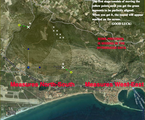Mappae mundi
program
Contributors
AuthorDaniel Ramos
Supported by
IMAGINARY, Universidade de Lisboa.
Explore the science of cartography and the geometry of map projections.
The main problem in cartography and mapmaking is representing the spherical surface of the Earth onto a flat map. No map can represent the Earth faithfully and without distortion. On the contrary, there are a multitude of maps, each one with different geometric properties and useful for different purposes.
Mappae mundi allows us to explore eight different projections of the Earth, using different tools to gain insigth on them:
- Tissot’s indicatrix: a mathematical visualization of distortion, which is a subtle magnitude to measure.
- Geodesics: the shortests paths that one wish to navigate through.
- Loxodromes: rhumb paths that we can follow with a compass and star orientation.
- Aspect: rotation of the globe allows to draw endless maps, centering the attention on our location or any region of the Earth that we wish to highlight.
Mappae mundi is a renovated version of The Sphere of the Earth, a program awarded with the first prize in the 2013 competition of Mathematics of Planet Earth.












